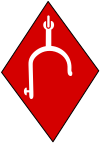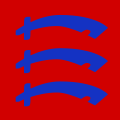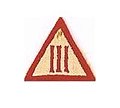World War I
During World War I the need to identify friendly troops in assaulting formations was made difficult by the new dispersion of troops across the battlefield. Beginning with the arrival of large number of Kitchener's Army troops in 1915, and widespread after the Battle of the Somme of 1916, each battalion of a division would have a particular sign of a distinctive coloured cloth patch, either sewn to the uniform jacket (on the sleeves, or the back of the tunic), or painted on the helmet. These distinguishing marks, known as "Battle Patches" were distinct from the Division signs, and were for the most part simple shapes and colours. The scheme for these Battle patches could be decided at division or brigade level or be based on regimental colours or insignia, and was in some cases continued down to company or even platoon level. This system did not prevent duplication across the divisions, a red square was worn by at least 14 battalions.
In most divisions the brigade could be deduced by the shape (for example 50th (Northumbrian)), colour (for example 55th (West Lancashire)) or design theme (for example 23rd) of the patch. Few divisions had a scheme of patches that had a specific brigade patch; those divisions which had such a scheme are shown below.
| 8th Division |  |
 |
23rd, 24th, and 25th Brigade patches. These patches were worn by brigade HQ staff only, others wore battalion specific patches. | |
| 20th (Light) Division |  |
 |
 |
59th, 60th, and 61st Brigade patches. These patches were worn by all in the brigade on both sleeves with the infantry battalions wearing a number of bars under the sign to indicate seniority. |
| 31st Division |  |
 |
 |
92nd, 93rd and 94th Brigade patches. These patches were worn by all in the brigade on the back below the collar. Battalion signs were worn on the sleeves which could also be used to deduce the brigade. |
| 32nd Division |  |
 |
 |
14th, 96th and 97th Brigade patches. These patches were worn by all in the brigade on the sleeves, with the infantry battalions adding bars below it indicating seniority, the same in each brigade. |
| 41st Division |  |
 |
 |
122nd, 123rd and 124th Brigade signs. These were not worn in the uniform, but used on sign posts and vehicles. The infantry battalions used numbers (or letters) in the sign as further identification. |
| 74th (Yeomanry) Division |  |
 |
 |
229th, 230th, and 231st Brigade patches. These patches were worn on the right arm, battalion patches (when present) on the left. |
More examples can be seen for the 38th (Welsh) divisions, the 146th, 147th and 148th brigades.
World War II

By the start of the Second World War, the British Army prohibited all identifying marks on its Battle Dress uniforms in 1939 save for drab (black or white on khaki) regimental or corps (branch) slip-on titles, and even these were not to be worn in the field. In May 1940 this was reinforced by Army Council Instruction (ACI) 419 prohibiting all formation marks on uniforms.
In September 1940 formation patches were authorized by ACI 1118 to identify the wearer's independent brigade or brigade group. A Brigade "Formation Badge" was sometimes worn when the formation was not attached to a division, as an Independent Infantry Brigade or brigade group (with attached other arms and services). When part of a division the infantry of a brigade wore one or more arm of service strips (2 inches (5.1 cm) by 1⁄4 inch (0.64 cm)), red for infantry, dark green for Rifle Regiments, indicating brigade seniority, one for the senior brigade, two for the intermediate and three for the junior. As an independent brigade or brigade group the infantry would only wear one strip, the other arms would also wear their arm of service strip. Battalion specific or general regimental patches, in addition to the shoulder title, could also be worn below the arm of service stripe, but the cost of these had to be borne from regimental funds, not the War Office.
In the British Army, ACI 1118 specified that the design for the formation sign should be approved by the general officer commanding the formation and reported to the War Office. A further order of December 1941 (ACI 2587) specified the material of the uniform patch as printed cotton (ordnance issue), this replaced the embroidered felt (or fulled wool) or metal badges used previously. In other theatres the uniform patch could be made from a variety of materials including printed or woven cotton, woven silk, leather or metal embroidered felt (or fulled wool).
Infantry
-
 1st Independent Guards Brigade Group
1st Independent Guards Brigade Group
-
 24th Infantry Brigade (Guards)
24th Infantry Brigade (Guards)
-
 29th Infantry Brigade
29th Infantry Brigade
-
 31st Independent Infantry Brigade
31st Independent Infantry Brigade
-
 32nd Infantry Brigade (Guards)
32nd Infantry Brigade (Guards)
-
 33rd Independent Infantry Brigade (Guards)
33rd Independent Infantry Brigade (Guards)
-
 36th Independent Infantry Brigade
36th Independent Infantry Brigade
-
 37th Independent Infantry Brigade
37th Independent Infantry Brigade
-
 38th (Irish) Infantry Brigade
38th (Irish) Infantry Brigade
-
 56th Independent Infantry Brigade
56th Independent Infantry Brigade
-
 73rd Independent Infantry Brigade
73rd Independent Infantry Brigade
-
 115th Infantry Brigade
115th Infantry Brigade
-
 116th Infantry Brigade Royal Marines
116th Infantry Brigade Royal Marines
-
 117th Infantry Brigade Royal Marines
117th Infantry Brigade Royal Marines
-
 148th Independent Infantry Brigade
148th Independent Infantry Brigade
-
 162nd Independent Infantry Brigade
162nd Independent Infantry Brigade
-
 204th Independent Infantry Brigade (Home)
204th Independent Infantry Brigade (Home)
-
 206th Independent Infantry Brigade (United Kingdom)
206th Independent Infantry Brigade (United Kingdom)
-
 212th Independent Infantry Brigade
212th Independent Infantry Brigade
-
 214th Independent Infantry Brigade
214th Independent Infantry Brigade
-
 218th Independent Infantry Brigade
218th Independent Infantry Brigade
-
 219th Independent Infantry Brigade
219th Independent Infantry Brigade
-
 223rd Independent Infantry Brigade
223rd Independent Infantry Brigade
-
 231st Independent Infantry Brigade
231st Independent Infantry Brigade
-
 301st Infantry Brigade
301st Infantry Brigade
-
 304th Infantry Brigade
304th Infantry Brigade
-
 Jewish Brigade
Jewish Brigade
Armoured and Tank
-
 2nd Armoured brigade
2nd Armoured brigade
-
 4th Armoured Brigade
4th Armoured Brigade
-
 6th Guards Tank Brigade
6th Guards Tank Brigade
-
 7th Armoured Brigade
7th Armoured Brigade
-
 8th Armoured Brigade
8th Armoured Brigade
-
 9th Armoured Brigade
9th Armoured Brigade
-
 20th Armoured Brigade
20th Armoured Brigade
-
 21st Army Tank Brigade
21st Army Tank Brigade
-
 21st Army Tank brigade, second pattern from 1944.
21st Army Tank brigade, second pattern from 1944.
-
 22nd Armoured Brigade
22nd Armoured Brigade
1st pattern, white background -
 23rd Army Tank Brigade
23rd Army Tank Brigade
-
 23rd Armoured Brigade
23rd Armoured Brigade
-
 24th Army Tank Brigade
24th Army Tank Brigade
-
 25th Army Tank Brigade
25th Army Tank Brigade
-
 27th Armoured Brigade
27th Armoured Brigade
-
 31st Army Tank Brigade
31st Army Tank Brigade
-
 32nd Army Tank Brigade
32nd Army Tank Brigade
-
 33rd Tank Brigade
33rd Tank Brigade
-
 33rd Armoured Brigade
33rd Armoured Brigade
-
 34th Armoured Brigade
34th Armoured Brigade
-
 35th Army Tank Brigade
35th Army Tank Brigade
-
 36th Army Tank Brigade
36th Army Tank Brigade
Post War
Aside from the deployment to Germany in the British Army of the Rhine, the employment of divisions has been rare since the Second World War, with Brigades often being the primary field formation.
Infantry
-
 1st Guards Infantry Brigade
1st Guards Infantry Brigade
-
 2nd Infantry Brigade
2nd Infantry Brigade
-
 3rd Infantry Brigade
3rd Infantry Brigade
-
 4th Guards Infantry Brigade
4th Guards Infantry Brigade
-
 5th Infantry Brigade
5th Infantry Brigade
also 5th Airborne Brigade -
6th Infantry Brigade
-
 12th Infantry Brigade
12th Infantry Brigade
-
 17th Infantry Brigade
17th Infantry Brigade
-
 23rd Brigade Group, in India 1946–1947.
23rd Brigade Group, in India 1946–1947.
-
 24th Infantry Brigade
24th Infantry Brigade
-
 27th Infantry Brigade
27th Infantry Brigade
-
 29th Infantry Brigade Group, in India 1945–1947.
29th Infantry Brigade Group, in India 1945–1947.
-
 29th Infantry Brigade
29th Infantry Brigade
-
 31st Independent Infantry Brigade.
31st Independent Infantry Brigade.
-
 39th Independent Infantry Brigade
39th Independent Infantry Brigade
-
 72nd Infantry Brigade Group, in India 1946–1947.
72nd Infantry Brigade Group, in India 1946–1947.
-
 107th (Ulster) Independent Brigade Group
107th (Ulster) Independent Brigade Group
Territorial Army
Worn from 1950 to 1967. -
 161st Independent Infantry Brigade
161st Independent Infantry Brigade
Territorial Army -
 162nd Independent Infantry Brigade
162nd Independent Infantry Brigade
Territorial Army
Armoured
-
 9th Independent Armoured Brigade (T.A.)
9th Independent Armoured Brigade (T.A.)
-
 23rd Independent Armoured Brigade (T.A.)
23rd Independent Armoured Brigade (T.A.)
-
 30th (Lowland) Independent Armoured Brigade (T.A.)
30th (Lowland) Independent Armoured Brigade (T.A.)
Modern
Brigades consisting of supporting units maintain their own insignia as well. For use in the field the patches are also issued in subdued colours, green-black, sand shades or tan-black.


Armoured and Mechanised
-
 1st Armoured Infantry Brigade
1st Armoured Infantry Brigade
-
 4th Mechanized Brigade
4th Mechanized Brigade
-
 7th Armoured Brigade
7th Armoured Brigade
-
 12th Armoured Infantry Brigade
12th Armoured Infantry Brigade
-
 20th Armoured Infantry Brigade
20th Armoured Infantry Brigade
-
 22nd Armoured Brigade
22nd Armoured Brigade
-
 33rd Armoured Brigade
33rd Armoured Brigade
Infantry
-
 15th Infantry Brigade
15th Infantry Brigade
-
 16 Air Assault Brigade
16 Air Assault Brigade
Obsolete -
 16 Air Assault Brigade
16 Air Assault Brigade
-
 19th Light Brigade
19th Light Brigade
-
 24th Infantry Brigade
24th Infantry Brigade
also 24th Airportable Brigade -
 39th Infantry Brigade
39th Infantry Brigade
-
 42nd Infantry Brigade
42nd Infantry Brigade
42nd (North West) Brigade (used from 2003) -
 43rd (Wessex) Brigade (used from 1994)
43rd (Wessex) Brigade (used from 1994)
-
 49th Infantry Brigade
49th Infantry Brigade
49th (East) Brigade (used from 1995) -
 51st Infantry Brigade
51st Infantry Brigade
-
52nd Infantry Brigade
-
 107th (Ulster) Brigade
107th (Ulster) Brigade
Territorial Army.
Worn from 1988 to 2002. -
 160th Infantry Brigade and Headquarters Wales
160th Infantry Brigade and Headquarters Wales
Supporting Arms
-
 1st Signal Brigade
1st Signal Brigade
-
 8th Engineer Brigade
8th Engineer Brigade
-
 11th Signal Brigade
11th Signal Brigade
-
 101st Logistic Brigade
101st Logistic Brigade
-
 102nd Logistic Brigade
102nd Logistic Brigade
-
 1st Intelligence, Surveillance and Reconnaissance Brigade
1st Intelligence, Surveillance and Reconnaissance Brigade
Notes
- Chappell pp. 5-6
- Hibberd pps. 9, 17, 23, 39, 43, 44, 50, 51, 55, 57, 58, 61
- Hibberd pp. 12-13
- Hibberd pp. 21-22
- Hibberd p. 38
- Hibberd pp. 38-39
- Hibberd pp. 45-46
- Chappell p. 44
- Davis p. 92
- ^ Davis p. 95
- Davis pps. 94, 97
- Davis pps. 95, 97
- Davis pp. 99-100
- ^ Cole p. 128
- ^ Cole p. 129
- ^ Cole p. 130
- ^ Cole p. 131
- Boulanger p. 248
- Boulanger p. 249
- ^ Cole p. 132
- ^ Cole p. 133
- ^ Cole p. 123
- ^ Cole p. 124
- ^ Boulanger p. 142
- Boulanger p. 143
- ^ Cole p. 126
- ^ Cole p. 125
- Boulanger p. 148
- ^ Cole p. 127
- Watson & Rinaldi p. 123
- Watson & Rinaldi p. 150
- ^ Watson & Rinaldi p. 151
- Davis (2) no. 128
- Cole (2) p. 64
- ^ Cole (2) p. 65
- Boulanger p. 228
- Cole (2) p. 67
- Cole (2) pp. 68-9
- Boulanger p. 234
- Cole (2) p. 68
- Cole (2) p. 69
- Boulanger p. 235
- Cole (2) p. 70
- Boulanger p. 245
- Cole (2) p. 98
- Cole (2) p. 99
- Cole (2) p. 100
- ^ Cole (2) p. 96
- Cole (2) p. 97
- Hodges pp. 484-496
- Hodges p. 492
- Hodges p. 493
- ^ Hodges p. 494
- Hodges p. 495
- Hodges p. 496
- Hodges p. 497
Bibliography
- Boulanger, Bruno (2015). WW2 British Formation Badges, A Collectors Guide. ISBN 9782960180206.
- Chappell, Mike (1986). British Battle Insignia (1). 1914-18. Oxford: Osprey Publishing. ISBN 9780850457278.
- Cole, Howard (1973). Formation Badges of World War 2. Britain, Commonwealth and Empire. London: Arms and Armour Press.
- Cole (2), Howard, N (1953). Badges on Battledress, Post-War Formation Signs; Rank and Regimental Insignia. Aldershot: Gale and Polden.
{{cite book}}: CS1 maint: multiple names: authors list (link) CS1 maint: numeric names: authors list (link) - Davis, Brian L (1983). British Army Uniforms & Insignia of World War Two. London: Arms and Armour Press. ISBN 0853686092.
- Davis (2), Brian L (1985). British Army Cloth Insignia. 1940 to the present. An illustrated reference guide for collectors. London: Arms and Armour Press. ISBN 0853687099.
{{cite book}}: CS1 maint: numeric names: authors list (link) - Hibbard, Mike; Gibbs, Gary (2016). Infantry Divisions, Identification Schemes 1917 (1 ed.). Wokingham: The Military History Society.
- Hodges, Lt. Col Robin (2005). British Army Badges. Butler and Tanner Ltd. ISBN 9780955146305.
- Watson, Graham E; Rinaldi, Richard A (2005). The British in Germany (BAOR and After): An Organizatinal History. Tiger Lily Publications. ISBN 9780972029698.